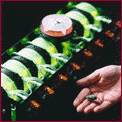


Objectives
Scientists have proposed that exposure to weightlessness affects the process of embryo development, possibly inducing abnormalities later in the life cycle of animals. This investigation was designed to help investigators determine the effects of microgravity not only on these physiological processes, but also on the functional and structural development of vestibular receptors in quail.
Shuttle-Mir Missions Approach
Synchronous control eggs were subjected to the same pre-incubation storage time and temperature from lay to incubation (6 days at 14-15°C). Synchronous control eggs were incubated in a flight-like incubator at temperatures similar to those of the flight eggs. Laboratory control eggs were also subjected to the same pre-incubation storage time and temperature as control and flight eggs, but were incubated in a commercial incubator at standard conditions (approximately 37.5°C). All control eggs were fixed in solution quantities and sequences identical to flight.
Results
Synchronous control eggs (incubated in the flight-like conditions) also showed much lower than expected viability at the older stages, but were more successful than the flight group. Laboratory control eggs, incubated in a commercial hardware, had normal viability of approximately 75%.
High mortality rates in young avian embryos have been reported for previous U.S. experiments flown on the Shuttle suggesting that space flight could be a significant factor in reducing viability. However the unexplained lower viability in ground tests, using the flight-like hardware, suggested a possible problem with the incubation conditions in that hardware.
Earth Benefits Publications
Barrett JE, Wells DC, Conrad GW (abstract) ''Effects of microgravity on embryonic quail eye development.'' Am. Soc. Grav. Space Biol. Bull. 1998; 12(1):32.
Hester, PY, Orban JI, Piert SJ, Gurieva T, Wentworth AL, Wentworth, BC. (abstract) ''Effect of preflight activities and launch dynamics on avian embryogenesis.'' Am. Soc.Grav. Space Biol. Bull. (in press).
Shimizu T. Effects of weightlessness on the avian visuo-vestibular system: immunohistochemical analysis. NASA Technical Memorandum, 1997; 66-67.
Bower AN, Shimizu T. Effects of weightlessness on the avian visuo-vestibular system: immunohistochemical analysis. NASA-1st Annual Partners in Research and Education Conference 1998.
Hester PY, Boda K. Egg rotation during avian embryogenesis. Am. Soc. Grav. Space Biol. 1997; 11:28.
Orban JI, Hester PY. Calcum uptake by quail embryos incubated in space. Am. Soc. Grav. Space Biol. 1998; 12:48.
Hester PY, Orban JI, Piert SJ, Gurieva T, Wentworth AL, Wentworth BC. Effect of preflight activities and launch dynamics on avian embryogenesis. Am. Soc. Grav. Space Biol. 1998; 12:64.
Orban, JI, Piert SJ, Guryeva TS, Hester PY. Calcium utilization by quail embryos during activities preceding space flight and during embryogenesis in microgravity aboard the orbital space station, Mir. FEBS Letters (submitted) 1999.
Hester PY, Orban JI, Sabo V, Boda K. Egg rotation during avian embryogenesis. Folia Veterinaria (accepted) 1999.
Principal Investigators
Page A. W. Anderson, M.D.
Gary W. Conrad, Ph.D.
Stephen B. Doty, Ph.D.
Cesar D. Fermin, Ph.D.
Bernd Fritzsch, Ph.D.
Patricia Hester, Ph.D.
Peter I. Lelkes, Ph.D.
Toru Shimizu, Ph.D.
Bernard C. Wentworth, Ph.D.
T. S. Guryeva, Ph.D.
Olga Dadasheva, Ph.D.![]()
Mir-18, Mir 19
For both missions, Mir-18 and Mir 19, quail eggs were launched on a Russian Progress spacecraft in a Russian supplied egg kit at ambient temperature. These eggs had been collected, over a period of days, from the quail colony at the Institute of Biomedical Problems (IBMP) in Moscow, Russia and hand-carried to the launch site. Upon arrival at Mir, the eggs were placed into the on-board incubator. On specified days, eggs were removed from the incubator and placed in a fixative solution for return to Earth. Upon return to Earth, embryos were assessed for gross morphology, sexual development and embryonic development.
Many of the quail embryos failed to develop as expected. Preliminary assessment of Mir-18 underdeveloped eggs indicated most embryos did not survive past 4-5 days of incubation. Only one embryo developed to an appropriate age. During the Mir 19 experiment, inflight development progressed to a further stage than noted with Mir-18 samples. Ten embryos developed past 7 days of incubation and one developed to 16 days. Approximately half of the underdeveloped eggs developed through 5-6 days. No abnormalities in gross morphology were seen in the embryos.
Many of the protocols developed during this investigation may prove useful in the treatment of diseases such as cancer, heart disease, genetically inherited syndromes and congenital defects.
Barrett JE, Wells DC, Conrad GW (abstract) ''Effects of microgravity on embryonic quail eye development.'' Invest. Ophthalmol. Vis. Sci. 1998; 39(4):S1037 (poster #4790-B541).
Gary Jahns, Ph.D.
NASA/Ames Research Center
Duke University Medical Center
Kansas State University
Hospital for Special Surgery
Tulane University School of Medicine
Creighton University
Purdue University
University of Wisconsin Medical School
University of South Florida
University of Wisconsin
Institute of Biomedical Problems
Institute of Biomedical Problems
![]()
|
|
Curator:
Julie Oliveaux
Responsible NASA Official: John Uri |
Page last updated: 07/16/1999
.gif)